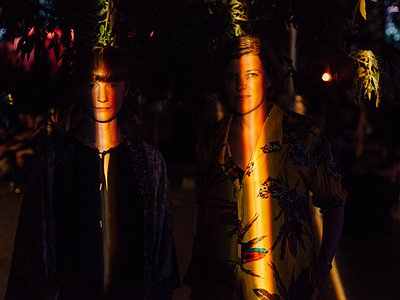Part 2
There are many descriptions of the ideal state of mind for being creative. What is it like for you? What supports this ideal state of mind and what are distractions? Are there strategies to enter into this state more easily?
F: I really enjoy bouncing ideas of other people, like playing in this project we seem to be able to go to the studio and always generate new material. Maybe because of its playful nature.
S: Yes! Playing and keeping it playful is essential. I find that we lose our creativity if it gets too serious
How do you make use of technology? In terms of the feedback mechanism between technology and creativity, what do humans excel at, what do machines excel at?
F: It is interesting re-shaping the sounds of the animals with a machine, I find, especially when working with the insect sounds, since the sounds are like mechanical or electronic music sounds. This is where you can play a lot with disassociation and create illusions for the listener.
S: The machines can trigger your creativity in the sense that they can give you ideas that you wouldn’t think about before you hear them. Sometimes they do something unexpected, which I often choose to keep, and repeat. But in all cases, it’s me tweaking the effect, and stopping when I hear a sound I like.
Production tools, from instruments to complex software environments, contribute to the compositional process. How does this manifest itself in your work? Can you describe the co-authorship between yourself and your tools?
F: I am using a Roland 404 sampler at the moment as well as multi-track software that acts like a drawing board offering more possibilities for working with material and developing tracks.
S: Yeah, hardware is nice, more hands on and direct. We use the same sampler and I also use a delay for my voice, but we use software for editing and writing our music. We record everything live in the studio, often quite improvised, then choose parts that we like and structure those into separate tracks. These tracks become like scores, so we take them back into the studio and practice them in our rehearsals for a live show. How do you see the relationship between sound, space and performance and what are some of your strategies and approaches of working with them?
S: We adapt our presentation to the current situation, and we have played in a big variety of contexts, galleries, clubs, parks, silent movie theatre for children … The audience, the architecture, the promoters, the weather, etc etc, we are constantly under the influence of external factors. Our music and sound keep their identity, but our intensity and energy is different every time, sometimes for the better, other times for the worse. But that’s half the fun of playing live.
Our sense of hearing shares intriguing connections to other senses. From your experience, what are some of the most inspiring overlaps between different senses - and what do they tell us about the way our senses work? What happens to sound at its outermost borders?
F: Some people have said that the sound of the animals reminded them of Australia. Often people have referred to the Lyre bird, the Australian bird that is able to mimic any sound from its environment. When you hear it's bird call it sounds like a cut-up of field recordings played back. I recommend you take a look at the David Attenborough youtube of the Lyer bird l have included in my recommendations, if you haven’t yet had the opportunity.
S: I think it’s fascinating how sound and frequencies can affect our bodies, and make us feel physically at ease or unwell. Our music however, is very associative, and we like to play with this alternation between the literal and the abstract so it can trigger people’s memory, both cognitively and sensorily. Like for instance with the lyrebird, if you grew up with the sound of it around you, hearing the sound of it now, will “take you back” to that place. At the same time there are a lot of other layers, that might make the experience less literal and more imaginative.
Art can be a purpose in its own right, but it can also directly feed back into everyday life, take on a social and political role and lead to more engagement. Can you describe your approach to art and being an artist?
S: I appreciate artists using their platform as a way to speak about political issues, I think it’s a great way of raising questions and enlighten people in an open and philosophical way. I don’t have a strong political agenda with my work, but I think my work can be a political statement in the sense that it creates diversity in the arts and music scene.
F: It’s not my main focus to make a political comment but I can see my personal experience and politics shapes how I behave and present work.
It is remarkable, in a way, that we have arrived in the 21st century with the basic concept of music still intact. Do you have a vision of music, an idea of what music could be beyond its current form?
F: At the moment and into the future, it seems there will be more music that is more tactile and immediate in a sense of how it affects us, in response to the post Internet era and discourse of the anthropocene epoch, as I can see a lot of artists incorporating elements of the human body and nature into their work.
S: It seems like all kinds of disciplines are melting together now, music festivals are programming dance performances, and choreographers making music scores, visual artists producing electronic music. We are slowly breaking down the boundaries, maybe in the future, we will have gotten rid of all the categories. Everyone just doing what they feel like.





